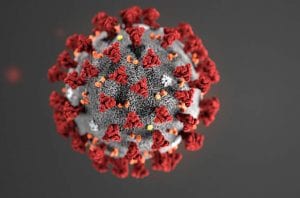Why are COVID-19 headlines dominating the world’s news? Is it overhyped?

CNN and NBC News have added a coronavirus menu item to their home page. Since COVID-19 first hit the news, the Wall Street Journal has published more than 1,800 articles about it. With two large cruise ships having been quarantined, and travel plans being forcibly changed for many, I’ve written about nothing else at Travelers United since late January.
So, why all the fuss? Why has this virus gotten so much attention? Are the COVID-19 headlines overhyped?
Publisher note: Due to the changing nature of this threat, check the
Centers for Disease Control Site for the latest information.
See also this John Hopkins coronavirus (COVID-19) tracker
Is COVID-19 actually as or more serious than influenza?
Many point out that while there are tens of thousands of articles about COVID-19, it’s infected just over 110,000 cases world-wide and killed fewer than 3,900, while it’s estimated that 34 million Americans contracted the flu this season resulting in 20,000 deaths. Moreover, as I write this article, it’s true that in the U.S., there are just 554 confirmed cases of COVID-19, resulting in 22 deaths.
It would seem that we should be far more alarmed about influenza than COVID-19, but there are important reasons why the World Health Organization (WHO), the National Institutes of Health (NIH) and the Centers for Disease Control (CDC) are so concerned about COVID-19, and why the world’s media has continued to focus on the virus.
We know much less about COVID-19 than we know.
The problems with COVID-19 headlines are its unknowns.
The world has lived with the flu for centuries. In the U.S., we’ve lived through major outbreaks of flu, including the famous “Spanish Flu” pandemic of 1918–19 in which the nation lost 700,000 souls. During that pandemic, medical science was helpless, able to do little more than treat the symptoms, but later in the 20th century, that changed.
In 1933, British researchers identified the human flu virus. In 1945, the first license to produce an influenza vaccine was issued in the U.S. In 1973, the modern flu vaccine was born, when the WHO began recommending what the composition of the vaccine would be, based on currently circulating strains of influenza. In the early 1990s, Oseltamivir, sold under the brand name Tamiflu, became available to treat influenza patients.
No vaccines or any specific drugs make for COVID-19 headlines.
Unlike influenza, there are no vaccines to prevent COVID-19 or help make its cases less severe. That isn’t surprising, since we’ve only known about this coronavirus for a few months. We’re unlikely to obtain a vaccine soon. The most optimistic timetable has been offered by John Shiver of Sanofi. They’re already working on a vaccine. He said it would take 18 months or longer to have a vaccine ready for licensing.
There are no drugs specifically manufactured to treat existing infections of COVID-19, unlike Oseltamivir for influenza. Researchers are testing existing antiviral medications on COVID-19, but none have been definitively identified to date.
As with influenza prior to the mid-twentieth century, medical professionals today can’t do much more than treat COVID-19 symptoms. Just like the flu in 1918, medical professionals are dying from COVID-19, infected while treating patients.
Today, with COVID-19 headlines, uncertainty persists.
Like influenza, COVID-19 is transmitted by respiratory droplets from infected people when they cough, sneeze or talk. We don’t yet know if COVID-19 can be transmitted airborne, like measles or chickenpox. If airborne transmission is possible, then it puts into serious question decisions about quarantine on ships and locations at which patients’ rooms’ ventilation can’t be isolated.
Experts have suggested COVID-19 might remain infectious for up to nine days on surfaces like doorknobs, tables, elevator buttons, hotel television remotes, etc., based on other coronaviruses, but we don’t yet know if that’s true.
The major reason for COVID-19 headlines is its fatality rate, currently calculated at 3.5 percent. Even if some experts are correct that it’s actually below one percent because mild cases of COVID-19 are unreported, it will be still higher than the fatality rate of flu last year, which was about 0.14 percent.
COVID-19 headlines help release public health experts’ recommended precautions.
Public health experts tell us that this disease is serious and that it’s imperative that we faithfully follow the CDC’s recommended precautions including:
• Avoid touching your eyes, nose and mouth.
• Stay home when you are sick.
• Cover your cough or sneeze with a tissue, then throw it in the trash.
• Clean and disinfect frequently touched objects.
• Wash your hands often with soap and water for at least 20 seconds, especially after using a bathroom, before eating or after blowing your nose, coughing or sneezing.
• If you can’t wash your hands, use an alcohol-based hand sanitizer that’s at least 60 percent alcohol.
It’s critical for the media to continue to keep the public informed.
While the constant COVID-19 updates may have panicked some in the general public who have cleaned out stores of unrecommended and often useless masks and respirators, as well as hand sanitizers, it’s critical for the media to continue to convey public health officials’ urgency and seriousness about COVID-19. It’s critical, at this time, for the media to continue to communicate up-to-date COVID-19 information and what the public can and should do about this virus.
READ ALSO IN TRAVELERS UNITED BLOG:
COVID-19: Cancel, postpone or take your trip?
How to self-insure for COVID-19 travel problems
After many years working in corporate America as a chemical engineer, executive and eventually CFO of a multinational manufacturer, Ned founded a tech consulting company and later restarted NSL Photography, his photography business. Before entering the corporate world, Ned worked as a Public Health Engineer for the Philadelphia Department of Public Health. As a well known corporate, travel and wildlife photographer, Ned travels the world writing about travel and photography, as well as running photography workshops, seminars and photowalks. Visit Ned’s Photography Blog and Galleries.



